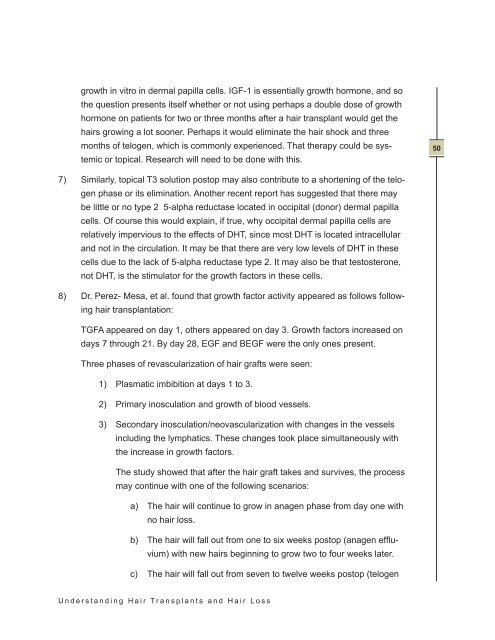Understanding Hair Transplants and Hair Loss - Pacific Hair
Understanding Hair Transplants and Hair Loss - Pacific Hair
Understanding Hair Transplants and Hair Loss - Pacific Hair
You also want an ePaper? Increase the reach of your titles
YUMPU automatically turns print PDFs into web optimized ePapers that Google loves.
growth in vitro in dermal papilla cells. IGF-1 is essentially growth hormone, <strong>and</strong> so<br />
the question presents itself whether or not using perhaps a double dose of growth<br />
hormone on patients for two or three months after a hair transplant would get the<br />
hairs growing a lot sooner . Perhaps it would eliminate the hair shock <strong>and</strong> three<br />
months of telogen, which is commonly experienced . That therapy could be systemic<br />
or topical . Research will need to be done with this .<br />
7) Similarly, topical T3 solution postop may also contribute to a shortening of the telogen<br />
phase or its elimination . Another recent report has suggested that there may<br />
be little or no type 2 5-alpha reductase located in occipital (donor) dermal papilla<br />
cells . Of course this would explain, if true, why occipital dermal papilla cells are<br />
relatively impervious to the effects of DHT, since most DHT is located intracellular<br />
<strong>and</strong> not in the circulation. It may be that there are very low levels of DHT in these<br />
cells due to the lack of 5-alpha reductase type 2. It may also be that testosterone,<br />
not DHT, is the stimulator for the growth factors in these cells .<br />
8) Dr. Perez- Mesa, et al. found that growth factor activity appeared as follows following<br />
hair transplantation:<br />
TGFA appeared on day 1, others appeared on day 3 . Growth factors increased on<br />
days 7 through 21. By day 28, EGF <strong>and</strong> BEGF were the only ones present.<br />
Three phases of revascularization of hair grafts were seen:<br />
1) Plasmatic imbibition at days 1 to 3 .<br />
2) Primary inosculation <strong>and</strong> growth of blood vessels .<br />
3) Secondary inosculation/neovascularization with changes in the vessels<br />
including the lymphatics . These changes took place simultaneously with<br />
the increase in growth factors .<br />
The study showed that after the hair graft takes <strong>and</strong> survives, the process<br />
may continue with one of the following scenarios:<br />
a) The hair will continue to grow in anagen phase from day one with<br />
no hair loss .<br />
b) The hair will fall out from one to six weeks postop (anagen effluvium)<br />
with new hairs beginning to grow two to four weeks later .<br />
c) The hair will fall out from seven to twelve weeks postop (telogen<br />
U n d e r s t a n d i n g H a i r T r a n s p l a n t s a n d H a i r L o s s<br />
50


